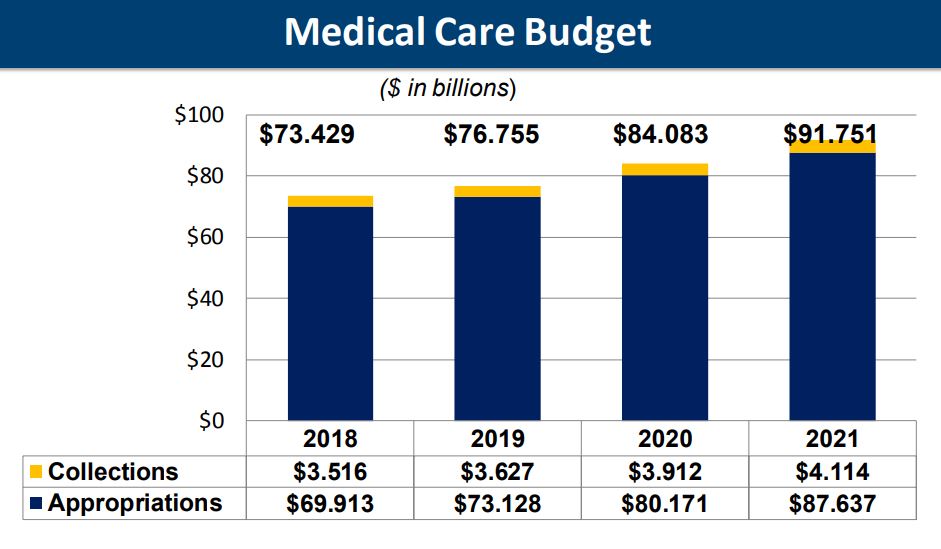
VA’s record-high 2020 spending request illustrates future, broader budget battles
As the Department of Veterans Affairs continues to implement a new version of its community care program, lawmakers will also debate whether VA is spending too ...
The coming debates in Congress over the budget at the Department of Veterans Affairs will illustrate just how tough it might be for lawmakers and the White House to strike a spending deal this year.
For both Congress and the White House, two sticking points will likely drive future budget debates at the VA and other departments: the administration’s plans to freeze discretionary spending for non-defense agencies at the Budget Control Act caps — and potentially controversial funding priorities.
And for VA, these two issues are very much intertwined.
VA’s budget has risen for five consecutive years now since 2015, and if the department gets its way, it will see another historic spending boost in 2020.
The department has more than a dozen modernization initiatives ongoing, a senior agency official told reporters Monday afternoon, and those priorities are driving VA’s record $220.2 billion total budget request for 2020.
VA is one of the only civilian agencies that stands to see a budget boost in 2020, according to the President’s request.
VA has asked for boosts to both its mandatory —$123.2 billion — and discretionary — $97 billion — funding accounts in 2020.
Mandatory funding is up as more veterans have been applying for benefits and VA has been issuing more awards in both volume and value in recent years, a senior agency official said Monday.
And while the VA’s 2020 budget requests shows, on one hand, just how many priorities the department is juggling in the next year, it also demonstrates a policy shift that may cause some headaches and perhaps partisan battles among appropriators in the coming years.
In passing the MISSION Act, which President Donald Trump signed into law last June, lawmakers moved the VA’s community care programs from mandatory to discretionary spending, meaning that whatever amount Congress does appropriate for fiscal 2020, it must fit within overall domestic spending caps.
In explaining its 2020 submission to reporters Monday afternoon, VA officials said this change accounted for much of the increase to the agency’s community care budget for the next year.
The President’s recent budget submission requests $8.9 billion to implement the VA MISSION Act. It includes $5.5 billion to continue to cover community care for veterans who used the previous VA Choice Program and an additional $2.9 billion for VA’s expanded access to private care under the MISSION Act.

“When you look at what appears to be substantial increases in the community care line, most of that is a function of the formerly mandatory funding becoming discretionary,” a senior VA official said. “The increase is not net new growth.”
But the question of whether VA is spending too much on private care at the expense of other agency priorities will also stump appropriators over the next several months, particularly as the White House has no plans to boost overall discretionary funding for non-defense agencies under the Budget Control Act caps.
“We recognize that Congress will have to make tough choices when deciding what discretionary programs to fund,” Republicans on the House VA Committee wrote in a March 8 letter to leadership on budget committee. “It is not without hint of irony that while the majority raises concerns about the existing caps, it also advocates for billions of new VA discretionary programs of questionable priority in a tight fiscal climate. We believe that fully funding the department is a top priority for the nation and we will fervently take up that fight under any cap structure.”
Rep. Phil Roe (R-Tenn.), the ranking member of the House VA Committee, was the lead member on the March 8 letter.
Some lawmakers, particularly Democrats, fear the department won’t have enough discretionary funds to pay for the new community care program and VA’s planned access standards under the MISSION Act, and appropriated dollars to support the agency’s own health programs, fill tens of thousands of vacancies, and juggle its many other modernization priorities.
VA officials said the department does have the ability, with congressional permission, to transfer discretionary funds from other accounts to pay for veterans medical care as the need arises. The trick, they said, will be in how they balance the desire for community care with VA’s other priorities.
The 2020 budget request does include funding for an additional net gain of 13,000 new employees at the Veterans Health Administration, senior agency officials said.
“I’ll acknowledge VHA has struggled to hire in the past,” an agency official said. “We do have additional hiring, recruitment and retention authorities under the MISSION Act. With our expanded focus on telehealth, we’re hoping we can hire in areas where we’ve not necessarily had as much challenge bringing in providers.”
VA last received additional budget authority for more hiring back in 2014, when Congress passed the Veterans Access, Choice and Accountability Act, the official said.
Is VA’s IT budget enough?
In addition, VA’s IT budget request increased by $240 million dollars in 2020, a 5.8 percent boost over 2019 funding. The bulk of the agency’s additional IT funding would go toward implementation of the VA MISSION ACT, recapitalize an aging network infrastructure, expedite its transition to the cloud and replace legacy financial management, burial operations support and benefits delivery network systems.
VA’s ongoing effort to implement Cerner’s commercial electronic health record and achieve interoperability with the Pentagon — and community care providers — would receive $1.6 billion in 2020, a 6 percent increase over 2019 levels.
About $1.1 billion of EHR funding would go toward VA’s contract itself with Cerner. Another $162 million and $335 million would cover program management and infrastructure support, according to VA’s request.
Senior VA officials said the department’s total IT budget doesn’t completely cover the agency’s technical debt.
That’s also a concern for members of Congress, including the Republicans who shared their views on the VA funding request with the House Budget Committee.
“The [Office of Information and Technology] appropriation has remained relatively static over the last several years, yet the enterprise technology needs of VA have only grown, and we add that the Electronic Health Record Modernization program’s needs have put additional strains on the already constrained OIT appropriation,” Roe and House VA committee Republicans wrote.
VA is also beginning to implement the Defense Department’s supply management system, called the Defense Medical Logistics Support system. VA will install this system about 90 days before it implements the Cerner electronic health record at the initial test sites in the Pacific Northwest, senior agency officials said.
Copyright © 2024 Federal News Network. All rights reserved. This website is not intended for users located within the European Economic Area.
Nicole Ogrysko is a reporter for Federal News Network focusing on the federal workforce and federal pay and benefits.
Follow @nogryskoWFED
Related Stories





